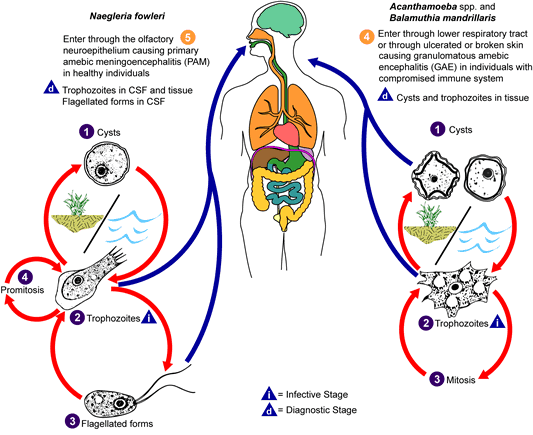Free-living amebic infection
|
|
| Contents |
Causal Agents
Naegleria fowleri and Acanthamoeba spp., commonly found in lakes, swimming pools, tap water, and heating and air conditioning units. While only one species of Naegleria is known to infect humans, several species of Acanthamoeba are implicated, including A. culbertsoni, A. polyphaga, A. castellanii, A. astronyxis, A. hatchetti, and A. rhysodes. An additional agent of human disease, Balamuthia mandrillaris, is a related leptomyxid ameba that is morphologically similar in light microscopy to Acanthamoeba.
Life Cycle
Free-living amebae belonging to the genera Acanthamoeba, Balamuthia, and Naegleria are important causes of disease in humans and animals. Naegleria fowleri produces an acute, and usually lethal, central nervous system (CNS) disease called primary amebic meingoencephalitis (PAM). N. fowleri has three stages, cysts, trophozoites, and flagellated forms, in its life cycle. The trophozoites replicate by promitosis (nuclear membrane remains intact) . Naegleria fowleri is found in fresh water, soil, thermal discharges of power plants, heated swimming pools, hydrotherapy and medicinal pools, aquariums, and sewage. Trophozoites can turn into temporary flagellated forms which usually revert back to the trophozoite stage. Trophozoites infect humans or animals by entering the olfactory neuroepithelium and reaching the brain. N. fowleri trophozoites are found in cerebrospinal fluid (CSF) and tissue, while flagellated forms are found in CSF. Acanthamoeba spp. and Balamuthia mandrillaris are opportunistic free-living amebae capable of causing granulomatous amebic encephalitis (GAE) in individuals with compromised immune systems. Acanthamoeba spp. have been found in soil; fresh, brackish, and sea water; sewage; swimming pools; contact lens equipment; medicinal pools; dental treatment units; dialysis machines; heating, ventilating, and air conditioning systems; mammalian cell cultures; vegetables; human nostrils and throats; and human and animal brain, skin, and lung tissues. B. mandrillaris however, has not been isolated from the environment but has been isolated from autopsy specimens of infected humans and animals. Unlike N. fowleri, Acanthamoeba and Balamuthia have only two stages, cysts and trophozoites, in their life cycle. No flagellated stage exists as part of the life cycle. The trophozoites replicate by mitosis (nuclear membrane does not remain intact) . The trophozoites are the infective forms and are believed to gain entry into the body through the lower respiratory tract, ulcerated or broken skin and invade the central nervous system by hematogenous dissemination . Acanthamoeba spp. and Balamuthia mandrillaris cysts and trophozoites are found in tissue.
Geographic Distribution
While infrequent, infections appear to occur worldwide.
Clinical Features
Acute primary amebic meningoencephalitis (PAM) is caused by Naegleria fowleri. It presents with severe headache and other meningeal signs, fever, vomiting, and focal neurologic deficits, and progresses rapidly (<10 days) and frequently to coma and death. Acanthamoeba spp. causes mostly subacute or chronic granulomatous amebic encephalitis (GAE), with a clinical picture of headaches, altered mental status, and focal neurologic deficit, which progresses over several weeks to death. In addition, Acanthamoeba spp. can cause granulomatous skin lesions and, more seriously, keratitis and corneal ulcers following corneal trauma or in association with contact lenses.
Laboratory Diagnosis
In Naegleria infections, the diagnosis can be made by microscopic examination of cerebrospinal fluid (CSF). A wet mount may detect motile trophozoites, and a Giemsa-stained smear will show trophozoites with typical morphology. In Acanthamoeba infections, the diagnosis can be made from microscopic examination of stained smears of biopsy specimens (brain tissue, skin, cornea) or of corneal scrapings, which may detect trophozoites and cysts. Cultivation of the causal organism, and its identification by direct immunofluorescent antibody, may also prove useful.
Treatment
Eye and skin infections caused by Acanthamoeba spp. are generally treatable. Topical use of 0.1% propamidine isethionate (Brolene) plus neomycin-polymyxin B-gramicidin ophthalmic solution has been a successful approach; keratoplasty is often necessary in severe infections. Although most cases of brain (CNS) infection with Acanthamoeba have resulted in death, patients have recovered from the infection with proper treatment. Amphotericin B has been successfully used to treat PAM caused by Naegleria fowleri.

